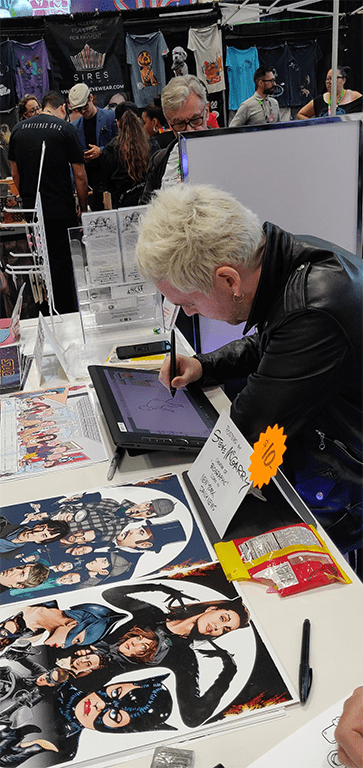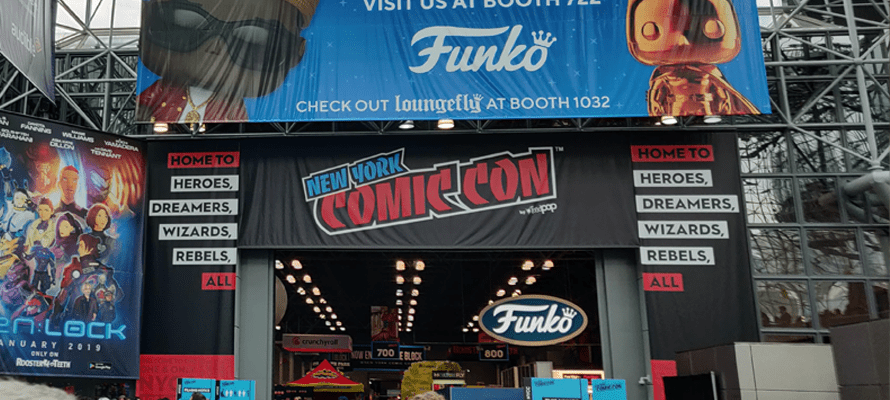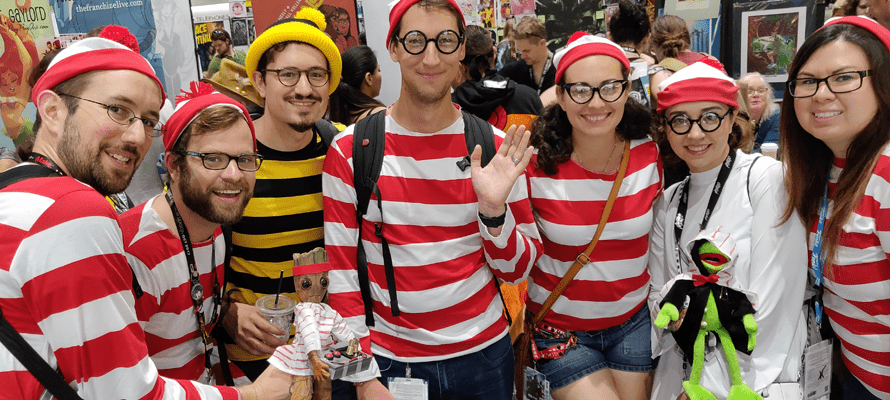The artist alley is the unsung highlight of any comic or anime convention. For those of you unfamiliar with them, that’s the part of the sales floor where artists sell prints and crafts—both fanart and their original properties—and take commissions for custom pieces.
Popular artists can take an overwhelming number of commissions over the course of the weekend, so many they can end up working on them for days afterwards. You’d think the speed and range of effects digital art offers— along with the influx of portable standalone pen computers like the Wacom MobileStudio Pro and tablets like the iPad —would make it a natural fit for artists trying to produce pieces at the speed the alley demands. Yet it’s still very rare.


Space
“Technology advances with apps and creative programs have definitely given artists a lot of options to make long, tedious techniques way easier,” agrees illustrator and fanartist, Tori Babuk. However, “Generally, I think it’s much easier for artists to access and carry around a sketchbook and pens/pencils.”
Drawing at a con is physically the same as doing a digital plein air painting, an art form that’s been taking off lately, and if you have a device that takes up a small enough amount of space (sadly, a Cintiq Pro 32” may not be the best choice), it won’t be any more obtrusive than a sketchbook. If your table’s packed to the brim, you can hold the device in your lap, prop it against the table edge, or invest in a tablet stand. If you have a camera tripod or a microphone stand, they also make attachments for those that hold a device at an optimal drawing angle.
Gayle Howe, runner of the one-woman art studio Robo/Pretty/Girl, recommends you have two spaces, one to draw publicly and one to draw privately. “I can do it right in the sales opening (the space on the table between merchandise racks where the vendor interacts with customers) to draw attention,” or if she’s feeling self-conscious about a certain piece, she’ll draw behind the display racks, away from the customers’ eyes. At GPCC, “the digital commissions were ‘18+, so drawing it out in the open would be inappropriate.”

Electricity
But the second, much larger hurdle, is electricity: many cons don’t provide it, and when they do, vendors usually have to purchase it through the venue. If it’s a hotel, it can be pricey, and if it’s a convention center, you might have to sell an organ.
“Tomo Creations” travels with a Wacom Cintiq Companion (previous version of the Wacom MobileStudio Pro) he uses for on-the-spot work. On the cost of charging it, “If it’s a small event, say a college con, it can be from $10 to $25, which is affordable,” but “power at [major] cons can go from $90 for a weekend up to $200.”
But there’s a simple solution:
“Always bring a battery pack,” insists Howe. “It’s easier and cheaper than paying for electricity.”
The beefier ones, which generally retail for $100 to $150, can power multiple devices all day on a single charge, then be refueled in your hotel room that night. “Consider not paying for electricity and it pays for itself ten times over every con season,” she says.
The only drawback? “THESE ARE NOT ALLOWED ON AIRPLANES,” warns one reviewer. Although even that, others dispute. Check for yourself before tabling at any cons you’ll have to fly to.

Staying Present
The third obstacle is that digital art can be more immersive than traditional art. This might not sound like a problem—in fact, it’s one of the medium’s greatest strengths—but it can be in the bustling environment of a con where you have to be both an artist and a salesperson.
“I often get very sucked into what I’m drawing and my concentration is on that piece,” says Babuk. “But when I work alone, I want to have my attention focused on my surroundings and be available to answer questions or make a sale.”
Complicating it further, “theft in the artist alley has been a growing issue … from cash boxes to display pieces. Running a table can get hectic as it is, and leaving an expensive iPad or tablet on the table in view isn’t always the safest place.”
To kill two birds with one stone, you can split your table with another artist, or bring along a friend to fill in for the areas you can’t cover, such as sales. This is good practice no matter what medium you’re working in, since tabling by yourself with no way to take a bathroom break is notoriously hard. “If I have a table helper or partner, I’m a bit more free to draw,” she says.
(Also, theft insurance for a device valued at $1,000 can be purchased starting around $30 a year.)
However, not all conventions are jam packed. Sometimes you have periods of downtime at the slower ones that can be used to work on personal projects. Eric Z. Goodnight is an illustrator who does artist alleys across the US, and this is his favorite use for his tablet. “This only clicked with me in the past year or so: During a con, there’s a lot of downtime you can spend drawing. When you’re not selling prints or talking to people, you can be working on art during time that would otherwise be lost because you have to sit there and mind your booth.”


Commission Management
A piece of advice I often come across is to watch the amount of work you take on. This applies to both the number of pieces and the amount of detail you put into them.
It’s standard for artists with large followings to only accept a certain number of online commissions at a time. Some practice this at cons: once they’ve filled all their “slots,” they focus on finishing them and selling their pre-made merchandise for the rest of the weekend.
The “detail” part is especially important to digital artists. When working with pencil or markers on a letter-sized piece of paper, there’s a built-in limit to how much detail you reasonably can put into one piece. With digital art, though, there’s the temptation to zoom in and over-render to the point where you’re perfecting individual pixels, making it hard to finish your work in a reasonable amount of time.
Many artists avoid this by offering work at levels of finish that are less than what they would do at home for a piece they could spend unlimited time on. For example, instead of taking commissions for full digital paintings, they’ll only offer drawings in the form of lineart, flat coloring, or simple cel-style shading, without backgrounds.
Taking it home is a common alternative. “I usually take a high volume of small commissions on-site and much smaller number of larger take-home commissions – so I have different forms for them,” says Tumblr’s How to be a Con Artist.
“Make sure your commissioner is clear on what you’re going to deliver,” they advise. “Some artists will choose to only email the finished digital art others choose to provide a print of their digital art to mail to the commissioner. If you’re shipping something, be sure to include that in the cost!” Most importantly, “be sure to take down accurate contact information as well.”


Prints
Speaking of prints, another issue is that despite digital art being the standard in fan communities, the convention scene is still set up for merchandise.
“When people want a commission, they typically want a physical object they can frame and put in their homes,” says Goodnight. Digital commissions are better for original characters than fanart of big name series, he speculates: if it’s a fan piece, buyers are more likely to want to hang it on their walls, where if someone’s getting their D&D character illustrated, they just want to see it rendered and will be less picky about the commission’s form.
Most artists simply do both.
Babuk: “I do traditional and digital commissions at cons. Traditional is what I usually am able to quickly finish at the con or in the hotel after the [artist alley] closes for the day. For digital, I usually wait until I’m back home and use a mix of my iPad and my Wacom Cintiq to finish a digital commission and email it to my client.“
Howe does both onsite, using an iPad for the digital ones, but still sending them by email. Her most recent artist alley was at Greater Philadelphia Comic Con: “They liked traditional art more, so I did eight traditional and two digital commissions.”
That doesn’t mean it’s impossible to physically manifest a digital piece during the weekend, though.
If there’s a 24-hour copy shop nearby (not naming names, but most of them are of a certain chain), you can make prints of the day’s commissions after you close up, then deliver them the next day. They offer multiple paper and finish options, and you can get an on-the-spot print that’s at least sellable, even if not quite the color fidelity you’d get from a specialist. This is another time you’ll want to have the customer’s contact information though, to make sure you’re not left holding an abandoned print for the rest of the weekend.
Working digitally at a con might seem daunting, but with a little investment and planning, it’s just as viable as ink on paper. And the more the technology advances, the more practical it gets…even for producing ink on paper.
External Links
Tori Babuk on Instagram
Robo/Pretty/Girl’s Instagram
Eric Z. Goodnight’s portfolio
Tomo Creations on Facebook
How to Be a Con Artist on Tumblr
![]()
![]()
About the Author: CS Jones
CS Jones is a Philadelphia-based freelance writer, illustrator, and occasional photographer. He spends his spare time listening to Spotify and waiting for trains. Someday, he’ll finish that graphic novel. In the meantime, his work is best seen at thecsjones.com or @thecsjones on Instagram.



